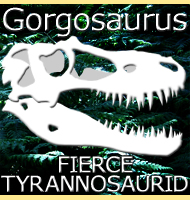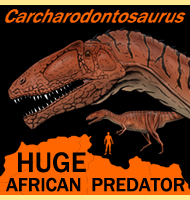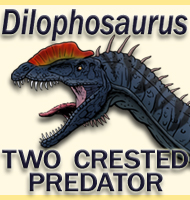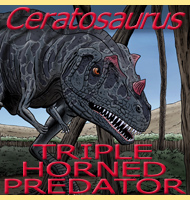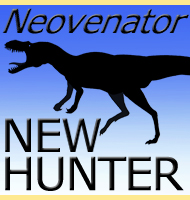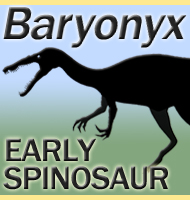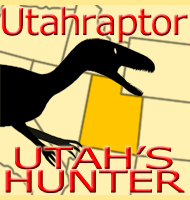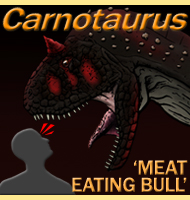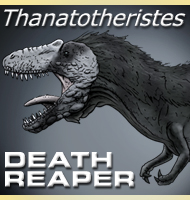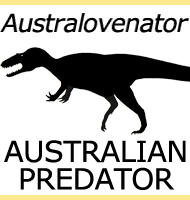


Saurophaganax
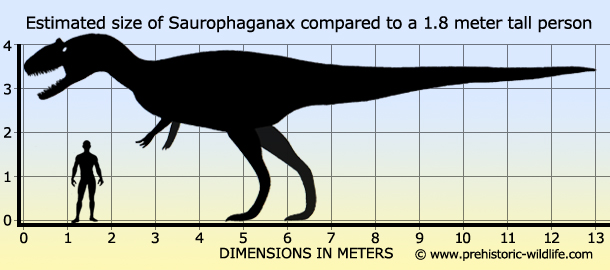
Name:
Saurophaganax
(Lizard-eating master).
Phonetic: Sore-oh-fag-ah-nax.
Named By: Daniel Chure - 1995.
Synonyms: Saurophagus maximus
(genus was
preoccupied).
Classification: Chordata, Reptilia, Dinosauria,
Saurischia, Theropoda, Allosauridae.
Species: S. maximus (type).
Diet: Carnivore.
Size: Estimated 13 meters long.
Known locations: USA, Oklahoma - Morrison
Formation. Possibly New Mexico as well.
Time period: Kimmeridgian of the Jurassic.
Fossil representation: Partial remains of the post
cranial skeleton, possibly representing several individuals.
Additional post cranial remains possibly also from New Mexico.
Discovery and classification
history of Saurophaganax
Saurophaganax
has a complicated taxonomic history due to the fact that it is still
only known from very partial remains, some of which bear a strong
resemblance to the smaller but more common Allosaurus.
This history
dates back to the discovery of the first material over 1931 and
1932 when John Willis Stovall recovered them from Kenton,
Oklahoma. The remains were first named Saurophagus maximus
in a
1941 article by Grace Ernestine Ray; however the official name
description did not happen until 1950. In 1987 a lectotype (a
bone used to identify further remains) was established and based upon
a tibia (lower leg bone) designated OMNH 4666.
It
was eventually realised that the genus name Saurophagus
had actually
been used back in 1831 to name a type of tyrant-flycatcher
(flycatchers are passerine birds common throughout the Americas),
and so a new name was required for the genus. In 1995 Daniel
Chure named the remains as Saurophaganax,
changing the original name
from ‘lizard-eater’ to ‘lizard-eating master’. Chure did not
treat this as renaming however, and rather than using the previous
lectotype of the tibia, he designated a holotype based upon a
vertebra (OMNH 01123. Not long after this however a new theory
came forward that Saurophaganax actually
represented an exceptionally
large species of Allosaurus on the basis that all
of the known bones of
Saurophaganax (with the exception of the
vertebrae) were very
similar to previously discovered Allosaurus
material. As such the
proposal was to rename Saurophaganax as a new
species of Allosaurus,
A. maximus.
Today
while some palaeontologists do this, it seems that most prefer to
recognise Saurophaganax as its own genus. The
vertebrae are the key
points in question here as they are quite different to those known from
Allosaurus. Additionally not all of the bones are
known for
Saurophaganax and it is currently difficult to tell
if the vertebrae
are the only difference between Saurophaganax and Allosaurus.
Despite
this however, Allosaurus does seem to be the
dinosaur closest in form
to Saurophaganax, and missing elements in
reconstructions of the
latter are based upon Allosaurus parts scaled up to
fit the larger
frame of Saurophaganax.
Saurophaganax
the dinosaur
At
around thirteen meters long Saurophaganax was
exceptionally large for a
Jurassic theropod, and could have rivalled both Tyrannosaurus
and
Giganotosaurus
of the Cretaceous for size. This large size would have
seen Saurophaganax living as the dominant predator
of late Jurassic
North America, but the price of being such a large creature means
that they would not have been as numerous as smaller predatory
dinosaurs. This is a simple principal based upon the fact that a
larger body requires a proportionately greater amount of food than
exactly the same body on a smaller scale. As such larger animals are
usually restricted to smaller populations as not to exhaust the amount
of available food (or in the case of Saurophaganax,
prey) in any
given ecosystem.
Currently
the fossil record supports this idea as Saurophaganax
is represented by
a tiny amount of fossil material when compared to other theropods like
Allosaurus (possibly one of the most common
theropods of the late
Jurassic). Despite this it should be remembered that Saurophaganax
may have been more common than the fossil record suggests, and that
in life not many Saurophaganax died in ways that
allowed them to become
fossilised. Additionally the same fact that it was such a large
dinosaur means that it is less likely that complete remains will be
found in the future as larger bodies take more material to bury them
and protect them from both scavengers and environmental conditions.
There
always seems to be a predatory niche for a small number of large
predators to be present in an ecosystem from Saurophaganax
at the end
of the Jurassic, Acrocanthosaurus
of the early to mid-Cretaceous to
finally the tyrannosaurs at the end of the Cretaceous. The large size
of Saurophaganax however has led to some
accusations that it would have
been slower than other predators and may have leaned more towards
scavenging than actual hunting. Saurophaganax may
have even been a
specialist scavenger that waited for other large theropod dinosaurs to
take down large prey that could supply Saurophaganax
with sufficient
food while these predators were not actually being big enough to
challenge Saurophaganax itself.
While
the above scenario is a plausible one, it may only represent one
facet of the behaviour of Saurophaganax.
Predators after all will
steal kills from smaller and less powerful predators while remaining
capable of killing their own prey when they have to. This can be seen
today with the lions of Africa taking prey from other but smaller cats
to grizzly bears taking on a pack of wolves to take their latest kill,
and even though they display scavenging behaviour, they are also
well documented making their own kills. Going back to the Jurassic of
North America and Saurophaganax would have had
plentiful access to
large herbivorous dinosaurs that probably would have even been a lot
slower than Saurophaganax despite its large size.
These would include
sauropods like Diplodocus
and Apatosaurus
as well as armoured dinosaurs
like Stegosaurus,
a dinosaur that is known to have come into conflict
with the smaller Allosaurus, so it seems quite
likely that the larger
Saurophaganax would have ventured to attack them as
well.
Further reading
- A reassessment of the gigantic theropod Saurophagus maximus from the
Morrison Formation (Upper Jurassic) of Oklahoma, USA, by D. J. Chure.
In, ixth Symposium on Mesozoic Terrestrial Ecosystems and Biota, Short
Papers, China Ocean Press, Beijing 103-106. - A. Sun & Y. Wang
(eds.).
Random favourites
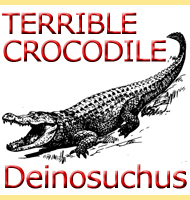 |
 |
 |
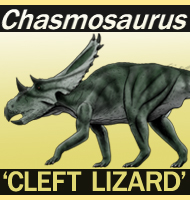 |
